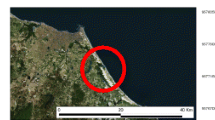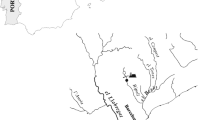Abstract
Estrogenic activities of river water from four representative cross-sections of the Yellow River (Zhengzhou section) and their effects on reproduction and development of fish were assessed. MVLN assay showed estradiol equivalents of river water from Yiluohe, Xinmanghe, Qinhe and Huayuankou cross-sections were 1.09 ± 0.11, 0.72 ± 0.01, 1.19 ± 0.19 and 0.80 ± 0.04 ng/L, respectively. Significant vitellogenin (VTG) inductions were observed in adult male Japanese madaka (Oryzias latipes) after 30 days of exposure to river water from Yiluohe and Qinhe cross-sections (p < 0.05). Hepatic-somatic index was significantly elevated in fish exposed to water from Qinhe cross-section (p < 0.05). A significant delay in time to hatching was observed in embryos treated by water from Xinmanghe cross-section (p < 0.05). Significant lower survivals were observed in fish treated by water from Yiluohe and Xinmanghe cross-sections after a full life cycle exposure (p < 0.05). Exposure of water from Yiluohe and Qinhe cross-sections induced significantly elevated VTG levels in the first sexually mature male fish (p < 0.05). Both the in vitro and in vivo bioassay demonstrate endocrine disrupting chemicals exist in the Yellow River (Zhengzhou section) and fish in Yiluohe and Qinhe cross-sections can be at a risk of reproductive and developmental impairment.






Similar content being viewed by others
References
Chang H, Wan Y, Hu JY (2009) Determination and source apportionment of five classes of steroid hormones in urban rivers. Environ Sci Technol 43:7691–7698
Fu MT (2011) Analysis on monitoring of water quality of functional areas in Manghe river and investigation of sewage outlets to the river. Yellow River 33:64–66
Furuichi T, Kannan K, Giesy JP, Masunaga S (2004) Contribution of known endocrine disrupting substances to the estrogenic activity in Tama River water samples from Japan using instrumental analysis and in vitro reporter gene assay. Water Res 38:4491–4501
Gárriz Á, Menéndez-Helman RJ, Miranda LA (2015) Effects of estradiol and ethinylestradiol on sperm quality, fertilization, and embryo-larval survival of pejerrey fish (Odontesthes bonariensis). Aquat Toxicol 167:191–199
Gong XL, Hou HR, Deng XY (2006) Evaluation of surface water pollution in Yiluohe basin. Yellow River 28:76–77
Hanselman TA, Graetz DA, Wilkie AC (2003) Manure-borne estrogens as potential environmental contaminants: a review. Environ Sci Technol 37:5471–5478
Huang B, Sun WW, Li XM, Liu JL, Li Q, Wang RM, Pan XJ (2015) Effects and bioaccumulation of 17β-estradiol and 17α-ethynylestradiol following long-term exposure in crucian carp. Ecotoxicol Environ Saf 112:169–176
Keller VDJ, Lloyd P, Terry JA, Williams RJ (2015) Impact of climate change and population growth on a risk assessment for endocrine disruption in fish due to steroid estrogens in England and Wales. Environ Pollut 197:262–268
Lee HR, Hwang KA, Nam KH, Kim HC, Choi KC (2014) Progression of breast cancer cells was enhanced by endocrine-disrupting chemicals, triclosan and octylphenol, via an estrogen receptor-dependent signaling pathway in cellular and mouse xenograft models. Chem Res Toxicol 27:834–842
Lei BL, Huang SB, Zhou YQ, Wang DH, Wang ZJ (2009) Levels of six estrogens in water and sediment from three rivers in Tianjin area, China. Chemosphere 76:36–42
Lei BL, Kang J, Yu YX, Zha JM, Li W, Wang ZJ (2013) β-estradiol 17-valerate affects embryonic development and sexual differentiation in Japanese medaka (Oryzias latipes). Aquat Toxicol 134–135:128–134
Lei BL, Kang J, Yu YX, Zha JM, Li W, Wang ZJ, Wang YP, Wen Y (2014) Long-term exposure investigating the estrogenic potency of estriol in Japanese medaka (Oryzias latipes). Comp Biochem Physiol C 160:86–92
Lu GH, Song WT, Wang C, Yan ZH (2010) Assessment of in vivo estrogenic response and the identification of environmental estrogens in the Yangtze River (Nanjing section). Chemosphere 80:982–990
Lv XF, Shao J, Song MY, Zhou QF, Jiang GB (2006) Vitellogenic effects of 17 beta-estradiol in male Chinese loach (Misgurnus anguillicaudatus). Comp Biochem Physiol C 143:127–133
Milnes MR, Bermudez DS, Bryan TA, Edwards TM, Gunderson MP, Larkin ILV, Moore BC, Guillette LJ Jr (2006) Contaminant-induced feminization and demasculinization of nonmammalian vertebrate males in aquatic environments. Environ Res 100:3–17
Overturf MD, Huggett DB (2015) Responses to various exposure durations of levonorgestrel during early-life stages of fathead minnows (Pimephales promelas). Aquat Toxicol 161:33–40
Pawlowski S, van Aerle R, Tyler CR, Braunbeck T (2004) Effects of 17α-ethinylestradiol in a fathead minnow (Pimephales promelas) gonadal recrudescence assay. Ecotoxicol Environ Saf 57:330–345
Pons M, Gagne D, Nicolas CJ, Mehtali M (1990) A new cellular model of response to estrogens: a bioluminescent test to characterize (anti)estrogen molecules. Biotechniques 9:450–459
Ru HJ, Wang HJ, Zhao WH, Shen YQ, Wang Y, Zhang XK (2010) Fishes in the mainstream of the Yellow River: assemblage characteristics and historical changes. Biodivers Sci 18:169–174
Shappell NW, Hyndman KM, Bartell SE, Schoenfuss HL (2010) Comparative biological effects and potency of 17α- and 17β-estradiol in fathead minnows. Aquat Toxicol 100:1–8
Shen GX, Song XY, Zhang D (2012) Hydrochemistry characteristics of Qin River (Henan section) in winter. J Water Resour Water Eng 23:43–46
Song WT, Lu GH, Wang C, Zhang HZ, Xu S, Qin J (2010) Study on environmental estrogen pollution in Yangtze River (Nanjing section) by an in vivo bioassay. Bull Environ Contam Toxicol 84:406–412
Song WT, Lu GH, Qi PD, Wang C (2011) Estrogenic effects of water from the Yangtze River (Nanjing section) on goldfish (Carassius auratus) after an early life stage exposure. J Environ Sci 23:1179–1185
Sun LW, Zha JM, Wang ZJ (2009) Effects of binary mixtures of estrogen and antiestrogens on Japanese medaka (Oryzias latipes). Aquat Toxicol 93:83–89
Tilton F, Benson WH, Schlenk D (2002) Evaluation of estrogenic activity from a municipal wastewater treatment plant with predominantly domestic input. Aquat Toxicol 61:211–224
Wang L, Ying GG, Chen F, Zhang LJ, Zhao JL, Lai HJ, Chen ZF, Tao R (2012) Monitoring of selected estrogenic compounds and estrogenic activity in surface water and sediment of the Yellow River in China using combined chemical and biological tools. Environ Pollut 165:241–249
Yellow River Basin Water Resour Prot Bur (2015) Bulletin of water resources quality of the key water function zone of Yellow River basin. http://www.yrbwrpb.gov.cn/GBShow.aspx?nid=13&InfoId=12
Acknowledgments
This work was financially supported by the National Natural Science Foundation of China (NSFC51409096, NSFC51404101) and Scientific Research Fund of Henan Provincial Education Department (13A610314).
Author information
Authors and Affiliations
Corresponding author
Rights and permissions
About this article
Cite this article
Song, W.T., Wang, Z.J. Occurrence and Biological Effects of Endocrine Disrupting Chemicals in the Yellow River (Zhengzhou Section). Bull Environ Contam Toxicol 97, 763–769 (2016). https://doi.org/10.1007/s00128-016-1930-4
Received:
Accepted:
Published:
Issue Date:
DOI: https://doi.org/10.1007/s00128-016-1930-4




